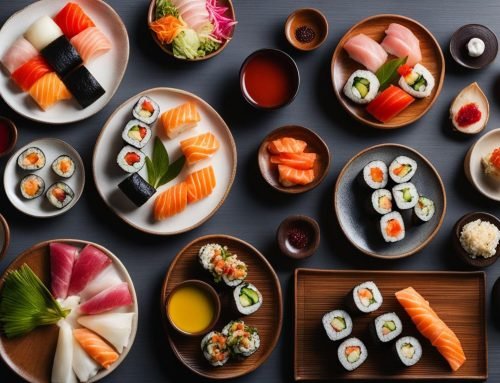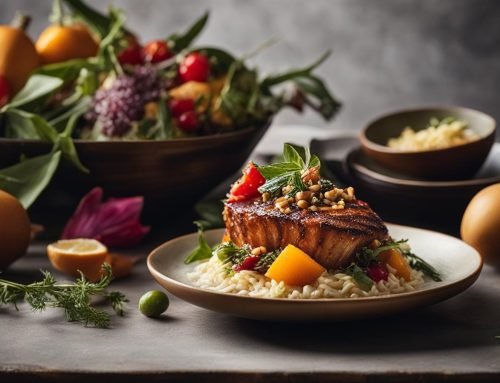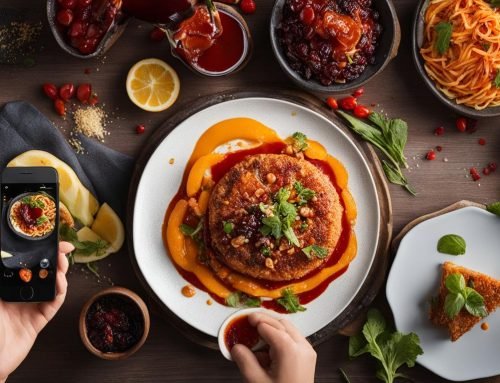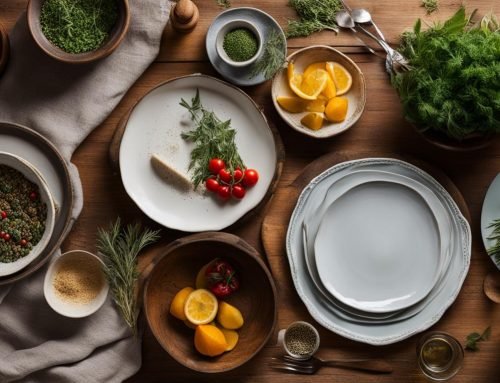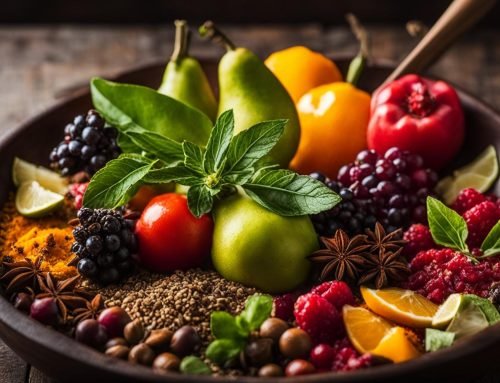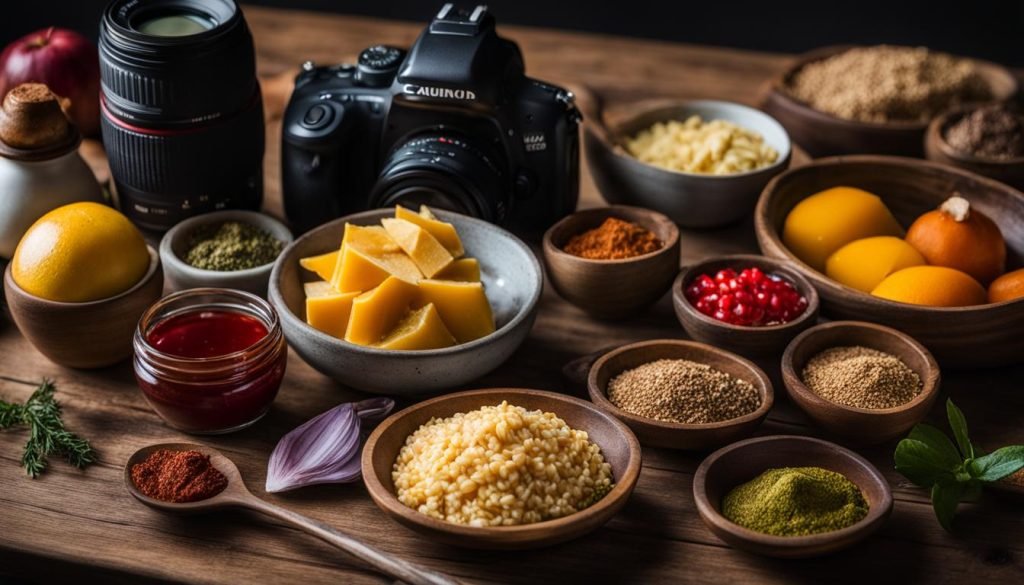
Capturing enticing food photos requires a unique blend of creativity and technical skills. Whether you’re an amateur food photographer looking to up your game or a professional looking for new inspiration, these essential tips will help you master the art of food photography.
Key Takeaways:
- Go small: Avoid overloading the plate to allow for framing and visual appeal.
- Set your table: Choose a complimentary table setting that enhances the photograph.
- Show off the ingredients: Use scattered ingredients to add color and depth to the plate.
- Be creative: Experiment with different angles and lighting to overcome challenges.
- Be fast: Capture photos quickly to preserve the freshness and aesthetic appeal of the food.
The Art of Styling: Tips and Tricks for a Well-Styled Plate
Regarding food photography, styling plays a crucial role in capturing visually appealing images. Through careful composition and attention to detail, you can elevate the presentation of your dishes and create stunning photographs. Here are some tips and tricks to help you master the art of styling for a well-styled plate.
Choose the right surface
The surface on which you place your food can have a significant impact on the overall aesthetic of your photograph. Consider using a wooden cutting board, a marble countertop, or a classic white plate as your base. Choose a surface that complements the colors and textures of your dish, creating a visually pleasing backdrop.
Start in the middle
When arranging the food on your plate, begin in the center and work your way outward. This technique helps maintain symmetry and balance in the composition. By starting in the middle, you can ensure that the focal point of your dish remains the main focus of the photograph.
Think like an artist
Don’t be afraid to get creative with your styling by adding additional elements to enhance the composition. Consider incorporating utensils, napkins, herbs, or sauces that complement the colors and flavors of your dish. These elements can add visual interest and depth to your photograph.
Pay attention to lighting
Proper lighting is essential in food photography. It can highlight the textures, colors, and details of your dish. Experiment with natural light or artificial lighting setups to find the best lighting conditions that complement your food. Be mindful of shadows and highlights, adjusting them as needed to achieve the desired effect.
Following these tips and tricks can take your food photography to the next level. Remember, styling is an art form, and with practice and experimentation, you can develop your own unique style and create visually stunning images that make viewers crave the flavors captured in your photographs.
Tips and Tricks to Capture a Professional-Looking Photo
When it comes to food photography, capturing a professional-looking photo goes beyond the aesthetics of the plated dish. Here are some tips and tricks to help you elevate your food photography game:
- Ensure correct exposure: Correct exposure is key to a well-lit and visually appealing photo. Use a white card or a reflector kit to adjust the brightness of the scene and bounce light onto the food, creating a balanced and well-exposed image.
- Experiment with angles: The angle at which you capture the food can make a significant difference in how it appears in the photo. Choose the right angle that flatters the food and avoids any distortion caused by wide-angle lenses.
- Avoid clutter: Keep the composition clean and focused on the subject. Remove any unnecessary elements or distractions that may take away from the main focus of the photograph.
- Utilize editing software: Editing software can be a powerful tool to enhance and refine your food photos. Consider using tools like Snapseed, VSCO, or Lightroom Mobile to fine-tune the image and make necessary adjustments.
When editing, pay attention to exposure, brightness, white balance, and saturation to ensure the photo looks professional and visually appealing. However, it is important to avoid excessive use of filters to maintain a natural look.
By following these tips and tricks, you can capture stunning food photos that stand out and showcase the beauty of the dish. Remember, practice makes perfect, so don’t be afraid to experiment and develop your own unique style along the way!
The Role of Plating in Food Photography
Regarding food photography, plating plays a crucial role in enhancing the dish’s visual appeal. How food is arranged and presented can significantly impact the overall aesthetic of the photograph. By paying attention to the art of plating, you can create stunning compositions that capture the essence of the cuisine.
One important aspect of plating is choosing the right surface for your dish. The surface should complement the food’s aesthetic and add to its visual appeal. Whether it’s a rustic wooden board or a classic white plate, selecting the appropriate surface can elevate the overall presentation of the dish.
In addition to the surface, the arrangement of the food is also essential in plating. Start by arranging the food from the middle of the plate and work your way outward, maintaining symmetry and balance. Incorporate additional elements like utensils or sauces strategically to enhance the composition and add visual interest to the photograph.
When plating the dish, consider the overall color balance and patterns. Experiment with different angles to highlight the best features of the food. By paying attention to the details of plating, you can create an appealing visual arrangement that entices the viewer and brings the dish to life in the photograph.
Importance of Lighting in Food Photography
Adequate lighting is one of the most crucial factors in achieving stunning food photography. The way you illuminate your subject can greatly impact the visual appeal of the image. When it comes to lighting, there are two primary options: natural light and artificial light.
Natural light: Utilizing natural light can result in beautiful, soft lighting that enhances the colors and textures of the food. The best time to shoot with natural light is during the day when the light is diffused and not too harsh. Positioning your set near a window or shooting outdoors can provide a steady source of natural light.
Artificial light: When natural light isn’t available or sufficient, artificial lighting can be a valuable alternative. Continuous lights and strobes are commonly used in food photography to provide controlled lighting conditions. Continuous lights allow you to see the lighting effect in real-time, while strobes provide powerful bursts of light for more dynamic shots. Experimenting with different light sources and colors can help create unique effects and set the desired mood.
Regardless of the lighting option you choose, it’s essential to pay attention to shadows and highlights. Shadows can add depth and dimension to the food, but be mindful of harsh shadows that can make the food appear unappetizing. The goal is to achieve a well-balanced lighting setup that accentuates the details and showcases the food in the best possible way. Proper lighting not only enhances the visual appeal but also provides more flexibility during post-processing for fine-tuning the exposure and overall look of the photograph.
Conclusion
Mastering the art of food photography requires a blend of technical skills, creativity, and attention to detail. By following these essential tips, you can elevate your food photos and create captivating visual narratives. Whether in plating, styling, lighting, or editing, each aspect contributes to the overall appeal and professionalism of your photographs.
Throughout this article, we have explored various food photography techniques and styling tips to help you capture exquisite images. From going small and showing off the ingredients to being creative and fast, these tips will ensure that your food photographs are visually appealing and enticing.
Additionally, we have discussed the importance of proper lighting in food photography. Adequate lighting not only emphasizes the colors and textures of the food but also allows for better control over exposure and post-processing.
Remember, practice and experimentation are key to developing your own unique style in food photography. With these tips, you’ll be well on your way to creating stunning images that capture the essence of delicious cuisine. So grab your camera, get in the kitchen, and let your creativity shine!
FAQ
What are some essential food photography tips?
Some essential food photography tips include avoiding overloading the plate with food, using scattered ingredients to add color and depth, being creative with angles and locations, capturing photos quickly, and experimenting with work-in-progress shots.
How can I create a well-styled plate for food photography?
To create a well-styled plate, you can choose the right surface, start arranging the food in the middle and work your way outward, think like an artist by adding additional elements, pay attention to lighting, and avoid clutter in the composition.
How can I capture a professional-looking food photo?
To capture a professional-looking food photo, you can ensure correct exposure, experiment with angles, avoid clutter, utilize editing software, adjust for exposure and saturation, and avoid excessive use of filters.
Why is plating important in food photography?
Plating is important in food photography because it helps enhance the aesthetic of the food, maintain symmetry, incorporate additional elements to enhance the composition, consider color balance and patterns, and experiment with different angles to highlight the best features of the dish.
What is the importance of lighting in food photography?
Lighting is essential in food photography because it emphasizes color balance and textures, brings out bright spots and shadows, affects the overall appearance of the food, allows for experimentation with different effects, and enables better post-processing and control over exposure.

